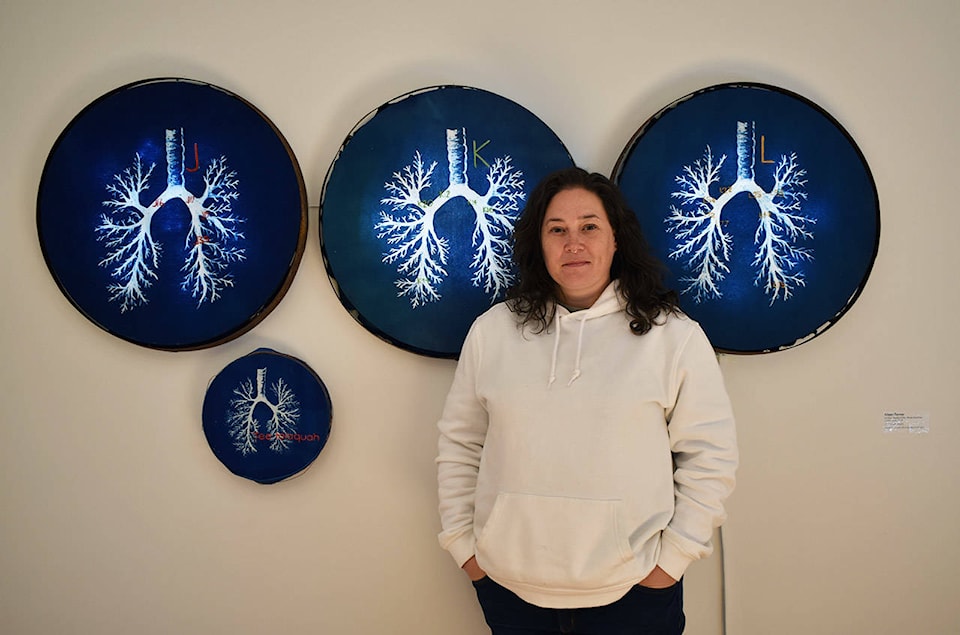When Aileen Penner was first gifted a set of bound Natural History magazines, she wasn’t sure what she would do with them.
“In some ways, you’re reluctant to cut up magazines like that, that are so old they are a record,” she said about the set, which stretched from 1968 to 2014.
The artist-in-residence at the Ranger Station Gallery had been working on her craft for about six months, the magazines sitting on her desk. Eventually, they became bricks, used to prop up her laptop as she worked or to flatten flowers.
That’s when she got an idea.
“I thought to myself, that would be kind of an interesting statement in the art show,” Penner said. “They are bricks if we don’t do anything about the information in them.”
The importance of the natural world is infused throughout Penner’s latest show “We hold our grief in the lungs,” taking place at the Ranger Station Gallery from now until June 30.
RELATED: Victoria artist plans to explore themes of nature and human interference during Harrison residency
She used the bound magazines to create shelves for some of her altar pieces, artwork made with items she’s collected over years. She also used them to create postcards featuring a few of the articles from the magazines.
“There was an article in the 1968 issue about climate change. There were advertisements about going to places before the tigers were extinct,” she said. “I started to realize that this knowledge is really important, but it doesn’t mean anything if you don’t do anything with it.”
But, the real goal of the exhibit is to help people understand the natural world, and the drastic changes that are happening to it, in a new, more personal way.
“If you don’t make it accessible for people, they won’t know what it is,” she said.
“You get a bigger emotional impact through art and artistic representation than sometimes just a newspaper article might,” she added.
In the other half of the Ranger Station Gallery, that personal connection comes to the forefront with a selection of 150 petri dishes, each carrying the name of a local plant or animal species, and representing the number of species that go extinct each day.
“They’re ones we see every day, like eagles and bufflehead birds,” Penner said. “It did happen (Sunday, June 2), people did kind of connect with one they really love.”
Hanging on the wall next to it is the focal point of Penner’s exhibit, the reason for its name and the embodiment of a story that many West Coast people have been watching unfold for years.
Three large embroidery hoops, featuring bronchial trees of the lung, hang back-lit from the wall. On each, a letter representing on of the three Southern Resident Killer Whale pods, an endangered population in British Columbia waters.
Beneath them, a smaller hoop that has gone dark, with the name Tee-talaquah.
Last year, a baby killer whale was born to one of the endangered pods. When it died, its mother carried it on its nose for 17 days.
RELATED: Killer whale pushing dead calf gets support from her pod
“I was trying to find a way in to try and talk about some of that grief, around particularly that baby,” she said. “I wanted to find a way in to talk about that collective grief.”
According to Chinese medicine, different emotions are held in different parts of the body. Grief, Penner said, is held in the lungs.
“I took that theme of ‘we hold our grief in our lungs,’ not to talk about holding it there, but to talk about acknowledging it and then releasing it,” she said.
“I’m hoping (this show) is a place where people can acknowledge their grief about what’s happening in the world, even just a little bit.”
Correction: an earlier version of this article said Penner’s magazine collection went until the 1970s. It actually goes from 1968 to 2014. We regret the error and have made the change in the article.
grace.kennedy@ahobserver.com
Like us on Facebook and follow us on Twitter
